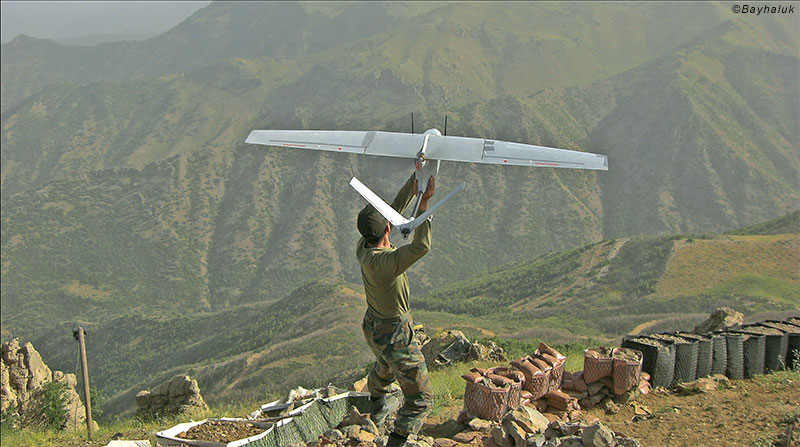The use of drones should move beyond surveillance and cover covert and offensive operations too
 Ajay Singh
Ajay Singh
On the night of 14 September 2019, 12-15 drones took off from an unknown location, perhaps from Yemen or Iran. It could have been from anywhere - a road, a grassy meadow - or even hurled by hand. They crossed the Saudi border undetected and then circled around the gigantic oil processing plants of Abqaiq and Khurais, which produced much of Saudi Arabia’s sweet light crude. Their low altitude flight path and small silhouette enabled them to evade detection by radar or other early warning systems and they reached their target undetected. The designator drone hovered overhead, and focused its cameras on the targets relaying images to its handlers hundreds of kilometers away.
One by one, the massive oil storage tanks, the oil processing plants, the control room and the oil trains, were painted by laser beams and designated. Then at exactly 4 a.m., the attack drones packed with high explosives, swooped down from the skies like hawks and unerringly hit their targets. The designator drone continued circling overhead firing laser beams on the targets – beams on which cruise missiles homed on to their targets. In less than 20 minutes, just 12-15 drones and five cruise missiles, each costing approximately USD1 million, had crippled the world’s largest oil plant and had incurred over USD6 billion worth of damage.
The drone attack in the Yemen-Saudi war is an example of its immense potential and increasing use in warfare. With just a dint of imagination, these small, potent weapons can cause disproportional damage and that too with limited cost and no danger to human life.
The Drone’s Flight
Drones have come a long way since they were first used in modern combat by the Israeli Defense Forces in Lebanon in 1982. A low flying drone was used to lure Lebanese missiles and radars deployed in the Bekaa Valley, into opening up and disclosing their locations, which enabled their destruction by following Israeli fighter jets.

Drones, though, have been used in different roles earlier. The first use of unmanned flying vehicles (to use its correct nomenclature) was by the Austrians who used unmanned balloons to drop bombs on Venice way back in the 1800s. During the World Wars they were used to practice anti-aircraft gunners, but little more. It is strange that a weapon of such potential remained unutilised till around the Vietnam War.
Then, concerned with the loss of aircraft and pilots, the USAF began a top secret programme called ‘Red Wagon’ to deploy UAVs over enemy-held territory. Over 3,435 UAV missions were flown over Vietnam, largely in surveillance and reconnaissance roles. And although 554 UAVs were lost, they did what they were supposed to do. They saved lives.
Their use was amplified in the First Gulf War when besides the traditional surveillance roles, they were used to carry laser designators and guide missiles on to their targets. A low flying drone also earned the distinction of having an Iraqi company surrender to it. The war also saw the first air combat involving drones when an Iraqi fighter shot down a US drone. They emerged as the weapon of choice in the war against terror as silent assassins. Armed with Hellfire and Paveway missiles they loitered for hours unseen, observing their targets, relaying images to their handlers back in the US and then released their lethal missiles when the target emerged. An estimated 3,400 militants have been eliminated by drone assassination — plus a few hundred civilians which pass off as the ubiquitous ‘collateral damage’ — in locations as far flung as Afghanistan, Pakistan, Syria and Libya,
Every army now uses drones in a variety of roles ranging from attack, surveillance, reconnaissance, logistic support, decoys and a host of other duties. Even non-state actors have resorted to them. The Liberation Tigers of Tamil Eelam (LTTE) used them effectively against the Sri Lanka Air Force (SLAF). Al Qaida and the Islamic State were known to have picked up drones for future use. Terrorist organisation could well fly explosive laden drones onto a crowd or vital targets, conduct political assassinations, or use them to keep track of security forces. Their use by both conventional and non-conventional forces will only increase and as technology makes them more potent, the roles they are called to play will increase manifold.
The Drone’s Punch
In the movie Uri – the Surgical Strike Indian scientists develop a bird shaped drone that merges with a flock of real birds atop a tree and then streams a flow of real time information through its cameras about a terrorist hideout. This sets the stage for the successful raid that followed. We do not know if such a drone was employed, but it is not really too far-fetched an idea.
The drone is likely to be the first weapon system to be deployed in any future conflict scenario. Indian and Pakistani drones routinely cross over from both sides. Israeli Searchers and Herons overfly Lebanon, Syria and Gaza with impunity. Russia uses them to monitor the Crimea and the border regions of Ukraine. China deploys them in support of her claims over the disputed islands of the South China Sea. And of course, the US uses them in Pakistan, Afghanistan, Syria, the Middle East, North Africa — everywhere. Even if this humble vehicle is lost, there is no dead or captured pilot to cause a national embarrassment. Also, the use of drones has an inherent deniability and can be used without significantly raising the thresholds.
In a world where drones are being used for everything from the delivery of pizzas, to fighting wild fires, it is but natural that their military applications will get enhanced as well. The incorporation of Artificial Intelligence, miniaturisation and stealth technology, coupled with greater speed and endurance has allowed them to become smaller, faster and virtually invisible. They can be easily integrated in the battlefield network, and used ubiquitously for any kind of operation — from strike to surveillance and everything in between.
When infused with Artificial Intelligence, drones can identify targets and then select and engage them. Using face-recognition techniques (used widely even in mobile phones) they can identify terrorist leaders or enemy generals to conduct selective assassinations. Larger drones can be used to deliver ammunition and supplies to forward troops — especially when they are under fire. Close-up images of the wounded — taken by hovering drones — can be transmitted to super specialists in base hospitals for expert diagnosis and instructions relayed to Battlefield Nursing Assistants for life-saving treatment and resuscitation.
You must be logged in to view this content.

